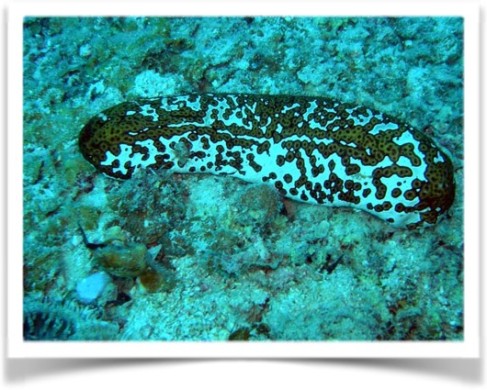With such vast diversity of life, it’s hard to imagine an adaptation that would be too out there to possibly exist. However, ejecting toxic strings out one’s anus seems to be stretching it… But for some of our dear sea cucumbers, it’s a last resort as a means for survival.

Fig 1. A Leopard Sea Cucumber looking as apparent as ever scooting across the ocean floor. Photo Credit: Anders Poulsen
Sea Cucumbers are a marine invertebrate belonging to Class Holothuroidea nested within Phylum Echinodermata. Some of their familiar fellow Echinoderms include the lovely sea stars and kelp-eating urchins. Even though these guys on the face of it look as though they’re light years away from being closely related, they all share two unique, unifying characters – tube feet and a water vascular system. Who knew right?

Fig 2. A brilliant display of the Leopard Sea Cucumber’s bright coloration. Photo Credit: Anders Poulsen
Many sea cucumbers are being bottom-dwelling deposit feeders, who spend their lives crawling along the ocean floor serving as a vacuum of the sea (Dyck et al. 2011). With their slow, yet adorable, creeping locomotion and succulent bodies, they may seem to be sitting ducks to a hungry on-looker, but they are far from defenseless (Dyck et al. 2011). Being equipped with such defenses as a mutable collagenous tissue, which allows them to stiffen their bodies, and saponins, which make them taste bad, sea cucumbers come pretty prepared for most attacks (DeMoor et al. 2003). However, some sea cucumbers come equipped with a defense reserved for only the most deadly of encounters – their cuvierian tubules.
These are long sticky threads that sea cucumbers belonging to Family Holothuriidae expel from their anus when extremely threatened to ensnare the encroaching, now very sorry, predator. Cuvierian tubules are enlargements of the respiratory tree that float around in the coelom, and once expelled, they begin to regenerate (regeneration takes on average about two weeks) (DeMoor et al. 2003). These tubules have special properties which include high tensile strength, the toxin holothurin, and the ability to lengthen considerably when in contact with water. All these properties are a recipe for a highly effective deterrent against a once determined predator.
As far as how these tubules effect different predators and are triggered to be released, there is most definitely a wide range of responses not only by the predators to the tubules, but by the sea cucumbers to the type of attack (Hamel and Mercier 2000). Upon tactile stimulation of a potential predator, rapid discharge of the tubules takes place, and the amount released and their precision is directly proportional to the intensity and location of the stimulus – the oral region of the body being the most sensitive and the anal region being the least (Hamel and Mercier 2000). If their anterior end is being attacked, they react much more quickly and release more tubules when compared to how they react to their posterior region being attacked. This makes sense when you think about it because their anterior end contains their most important body parts, while their posterior end has greater regenerative properties (Hamel and Mercier 2000).
Now when looking at how different predators are effected, we see that predators such as other echinoderms, molluscs, and crabs become entangled and repelled by the tubules, whereas they do not entangle, but repulse, fish (Hamel and Mercier 2000). Unfortunately though, specialist predators on sea cucumbers who posses these cuverian tubules are not deterred by their release whatsoever (Hamel and Mercier 2000). It is also important to understand that once these tubules have been expelled, these cuverian-tubule-regenerating sea cucumbers are much more vulnerable to predators that would have otherwise been easily deterred (Hamel and Mercier 2000). That’s why sea cucumbers also have this unique ability to retract the tubules that did not stick to anything – without them they may just be toast (Hamel and Mercier 2000)!.
Hopefully now you not only have a greater appreciation for the diversity of weirdness that can be seen through out the world we live in, but that performing such odd tasks as shooting sticky threads out one’s anus is a way of life and necessary means of survival for some of our fellow earthlings.
References
DeMoor, S. Herbert Waite, J. Jangoux, M. Flaming, P. (2003). Characterization of the adhesive from the cuvierian tubules of the sea cucumber Holothuria forskali (Echinodermata, Holothuroidea). Mar. Biotechnol. 5, 45 – 57
Hamel, J. and Mercier, A. (2000). Cuverian tubules in tropical holothurians: usefulness and efficiency as a defence mechanism. Mar. Fresh. Behav. Physiol. 33, 115-139
Van Dyck, S., Caulier, G., Todesco, M., Gerbaux, P., Fournier, I., Wisztorski, M. and Flammang, P. (2011). The triterpene glycosides of Holothuria forskali: usefulness and efficiency as a chemical defense mechanism against predatory fish. J. Exp. Biol. 214, 1347-1356
